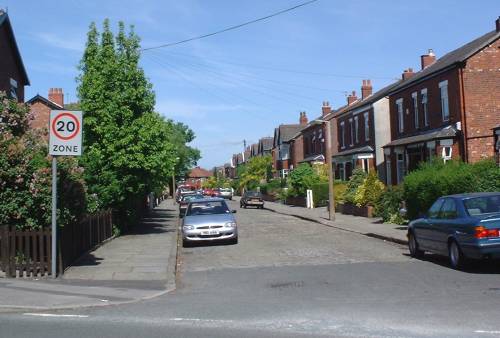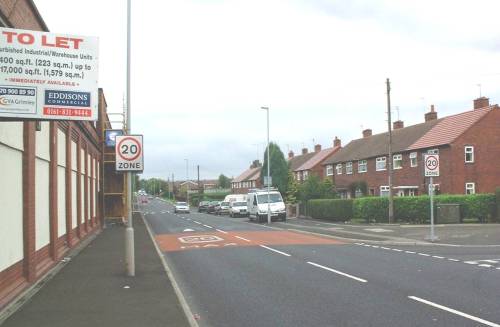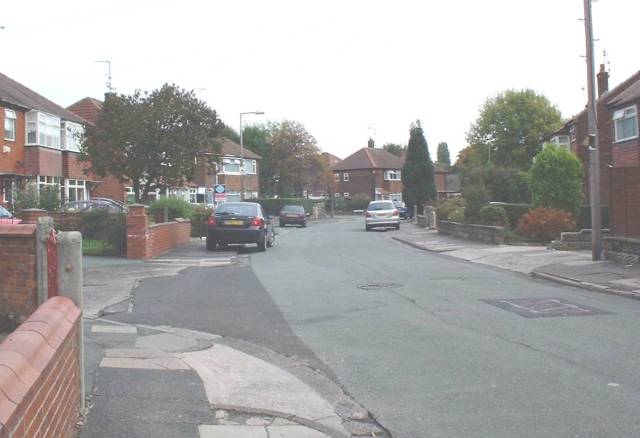Is Twenty Plenty?
How a misguided safety policy is increasing pollution and slowing our towns to a crawl

|
20 mph limits are rapidly spreading across residential areas in British towns. |
Really Slow
Go out in your car and try to drive at 20 mph. Not the kind of speed you think you might get away with in a 20 mph limit, but actually at an indicated 20 mph or less on your speedo. Most cars won’t be happy in third gear, and you’ll need to change down into second. And, unless you’re on a very narrow or twisting road, or one lined with parked cars either side with room for only one vehicle to proceed, it will feel extremely slow indeed.
Spreading like a Cancer
Yet, with the relaxation of government guidelines, 20 mph zones are rapidly spreading across our urban areas. They are taking in areas of Victorian terraces, post war council estates, areas around schools, shopping streets, city centres and even in some places main through roads. There are an increasing number of places where 20 mph is now the norm, with only a handful of principal routes remaining at 30 mph, historically the default speed limit in urban areas. Take a look at the map of Denton in Tameside, for example, where all the small white roads in each of the four quarters around the crossroads of the two A-roads (A57 and A6027) are now 20 mph, in the south-western corner in particular covering a very extensive area. If this kind of policy hasn’t yet come to your town, the odds are it will do before too long. It is all too easy for local councils to implement 20 mph limits and claim they are acting to improve the safety of children, pedestrians and cyclists, something which any reasonable-minded person must support.
Collision Speeds
The statistic is often quoted that there’s a 95% probability of a pedestrian involved in a collision with a car travelling at 40 mph being killed. At 30 mph, it’s 50%, but at 20 mph, it’s only 5%. Taken in isolation, this is broadly true, and on the face of it, appears to be an irrefutable argument for 20 mph limits. But, in fact, only 0.55% of pedestrian injuries in road accidents prove to be fatal. This suggests that these statistics do not adequately cover the range of accidents.
It also completely fails to take into account the fact that free travelling speeds bear little relationship to actual impact speeds. In virtually every collision between a vehicle and a pedestrian, the vehicle will have slowed substantially from its free travelling speed before the impact. It has been suggested that the average impact speed in a fatal collision is a mere 12 mph. Drivers should only travel at a speed where they can stop within the distance they can see to be clear, but in most situations on free-flowing urban roads this is not inconsistent with a 30 mph limit. Reducing the maximum speed to 20 mph is unlikely to have much impact on actual impact speeds in collisions, particularly if drivers’ attention wanders from being made to travel at a speed well below what they perceive as a safe speed for the road in question.
The small minority of collisions where there has been little or no reduction of vehicle speed before impact are just as likely to occur on motorways or major trunk roads than on residential streets. Nobody is suggesting (I hope) that speeds on strategic roads should be reduced to 20 mph on the remote offchance of a pedestrian colliding with a car. Likewise, nobody is proposing that trains in urban areas should be made to keep below 20 mph, even though, in terms of the number of passenger miles and freight ton-miles carried, there are far more child trespassers killed on the railways than child pedestrians on the road network.
No Speed is Always Safe
The implementation of 20 mph zones will increase the perception that, in residential areas, 20 mph is always safe. This is manifestly untrue, and many fatal collisions occur with impact speeds well below 20 mph. On any typical urban journey, maximum safe speeds will vary from close to zero mph to 30 or even a little above, a crucial point that is undermined by the “stick to 20” message. It is a commonplace argument, but nonetheless containing much truth, that an alert driver who varies his speed up to 30 mph where safe to do so is likely to be safer than one who sticks rigidly to 20, but pays little attention to the driving task. By apparently reducing safe driving to a number, the widespread use of 20 mph limits is likely to erode drivers’ ability to select safe and appropriate speeds. There is already evidence that the average severity of pedestrian injuries from accidents in 20 mph zones is greater than that in 30 mph areas, suggesting that distraction and inattention are coming into play.
It should also be remembered that a full 25% of child pedestrian fatalities result from reversing manouevres, where observation is the key factor, and the actual speed is likely to be under 5 mph. This is a sad reminder that no speed can ever be regarded as absolutely safe, and an over-emphasis on “magic numbers” such as 20 mph or 30 kph may be counter-productive.
Pedestrian Risk-Taking
Even if there were safety gains from reducing speeds, to a large degree they could be dissipated by pedestrians taking more risks in the vicinity of vehicles. The areas where the risk of pedestrian injury is highest are often those where vehicle speeds are lowest, but pedestrians and vehicles mingle closely together. You can see this from the way pedestrians walk right through the traffic when it is slowed to a crawl on busy city streets in rush hour. They know that at 5 or 10 mph, vehicles will be able to stop for them, which they might not be able to do at 30 mph, but they are using this for their own convenience rather than to increase their safety. In real-world situations, there is in general an inverse correlation between vehicle speeds and the level of pedestrian casualties, so it does not automatically follow at all that slower speeds will reduce casualties, if traffic volume remains unchanged.
Slow and Dirty
Another issue is that slower speeds would increase pollution. This may seem counter-intuitive, but any vehicle with an internal combustion engine will need to be driven in a lower gear at 20 mph than at 30 mph. The revolutions per minute will be similar, but the revolutions per mile travelled will be half as much again, leading to an increase in fuel consumption and emissions. In fact, the gearing on typical modern vehicles (such as, for example, a 1.6 litre Ford Focus) is often such that they will cruise at 30 in fourth, but are only comfortable at 20 in second, so their rpm would actually be higher.

|
20 mph zones now extend far beyond minor residential streets to include substantial main roads. |
Abusing the Principle
Although, in general, 20 mph limits have been confined to what are claimed to be residential areas, there are a growing number of locations where they have been applied to main through routes – see, for example, this unclassified route through Broadbottom in Tameside, which is a main road, not a residential access street, with no alternative route for several miles in either direction. This often leads to the ludicrous and confusing situation where a main road has a 20 mph limit, but small side streets leading off it (where the real-world safe speeds may be much lower) are 30.
This trend has been developed by some anti-car campaigners into the concept of “20 mph cities” where all roads including major through routes are reduced to 20 mph. In most large towns and cities, entirely rational journeys of 7-10 miles or more are routinely made entirely on built-up, 30 mph roads. To cut this to 20 mph would extend many off-peak journey times by not far short of 50%. 30 minutes to 45 minutes, for a daily journey, is an enormous difference. It would result in a huge increase in costs for any business involved in delivery or service activities. It would also greatly increase pollution levels, and end up turning our major cities into a choking, grinding crawl. This surely is not what they had in mind?
Crowded Roads
If asked, most people would probably agree with the proposition that “if cars travelled more slowly, it would give pedestrians more time to cross the road.” But in fact this is quite untrue. If the volume of traffic remained the same, the elapsed time between vehicles would also be exactly the same, and the physical separation distance between them would be less. The roads would appear fuller, and pedestrians would more often have to make a judgment to cross in front of a vehicle rather than waiting for it to go past, which would increase the possibility of a collision if they estimated the vehicle’s speed incorrectly.
Indeed I would suggest there is probably an optimum speed for vehicles to pass pedestrians on residential roads. Clearly they don’t want them rushing by at a dangerous speed, but on the other had they don’t want them crawling along at little more than walking pace, and remaining in sight and earshot for much longer. Cars don’t have to be kerb-crawling to create a nuisance, and those travelling at little more than walking pace, for whatever reason, are annoying. This optimum speed is probably around 25-30 mph.

|
A typical minor residential road - 30 mph limit, no humps, and virtually no traffic travels above 25 anyway. Sensible urban road design results in appropriate speeds without resort to enforcement. |
Effective Laws Depend on Consent
I have no problem with the concept that roads used purely for residential access are places where motorists should proceed slowly and cautiously. But that is something that can, and should be achieved by road design rather than by enforcement. Indeed I have no problem with “home zone” schemes where they are used to alter the environment in roads used purely for residential access, to blur the traditonal distinction between road and pavement areas. Indeed most new housing developments are constructed in this way. But home zones should be self-enforcing, and should also not be abused as a deterrent to through traffic. No road with any through traffic whatsoever should be configured as a home zone.
It is my view that no speed limits below 30 mph should be enforceable on British roads, except perhaps in a very limited number of locations where the road environment is in some way deceptive and suggests that visibility is better than it actually is. Lower speeds, where desirable for safety, should be achieved by design and consent, not prosecution.
There are plenty of locations within the UK where traffic routinely travels at 20 mph or less, despite the posted limit being 30 mph or in some cases as high as NSL. Equally, most traffic on minor residential roads travels below the 30 mph limit. The speeds people choose to travel at are dictated by the road configuration and drivers’ perceptions of what is safe, not by what the limit happens to be. The other side of the same coin is that reducing a speed limit, in isolation, is unlikely to have much impact on actual speeds. Several studies have shown that 20 mph limits on their own make little difference to the speeds drivers choose to travel at in residential areas, which remain in general around the 25-30 mph mark. The police are never going to be able to carry out much enforcement activity on minor residential streets, and the widespread use of speed cameras would be prohibitively expensive, so any limit is going to have to be effectively self-enforcing.
The most popular way of doing this is of course by so-called “traffic calming” – but there’s plenty of evidence that turning roads into obstacle courses does not improve safety overall and has a particularly negative effect on response times for the emergency services. This is dealt with in detail in another article. Surely, rather than littering streets with unsightly and dangerous humps, local authorities should be examining the characteristics of residential streets where drivers do voluntarily keep below 30 mph and seeking to extend those lessons to the minority of locations where they do not.
Of course any speed limit is likely to be ignored by a small, irresponsible minority often characterised as “boy racers”. But this will happen whether the limit is 20 or 40, and surely this problem is better dealt with by targeted enforcement and re-education rather than by making the generality of responsible drivers suffer through restrictions that are in any case ineffective in deterring the offenders. It’s about as logical as banning alcohol because some people drive when drunk.
Fairness and Consistency
Realistically, even though their practical benefits may be highly questionable, 20 mph zones are here to stay for the foreseeable future. But surely to make them more acceptable some basic guidelines should be applied to ensure that they are used consistently purely in a residential context, and not as a means of frustrating and delaying through traffic:
- no point in a 20 mph zone to be more than a set distance from a 30 mph limit. I would suggest this should be no more than a third of a mile (600 yards) but the key principle is that the maximum distance should be laid down
- a continuous network of 30 mph roads to be retained, thus preventing the application of 20 mph zones to through routes. This would mean no journey needed to involve more than two short stretches of 20 mph limit, thus limiting any increase in journey times
- any 20 mph zones around schools on roads that would otherwise have 30 mph limits should be part-time limits only marked by prominent flashing lights
(October 2003)